![]()
Nawasalimuni nyote katika jina la nchi yetu nzuri Tanzania, Jina ambalo huko nyuma sote tuliliimba “Tazama ramani utaona nchi nzuri, yenye mito na mabonde mengi ya nafaka…nchi hiyo mashuhuri huitwa Tanzaniaaa!” Hakika wimbo huu vijana wengi siku hizi wanashindwa kuuimba, kwa nini? Uzuri wa taifa lao haupo tena, umepotezwa na baadhi yenu watumishi wa umma wasio na uadilifu. Sio siri vijana wetu kwa muda mrefu wameshindwa kujivunia taifa lao, wameshindwa kuongea mbele za watu kwa sauti kubwa kwamba wao ni Watanzania, uzuri wa taifa lao na sifa nzuri ya nchi yao imeharibiwa na vitendo kama ufisadi uliokithiri ambao umesababisha wachache katika taifa kunufaika huku wengi wakiteseka. Ndugu zangu watumishi wa umma, Ni kwa kupitia jina la nchi hii ndiyo leo nawaandikieni, kuwakumbusha juu ya wajibu wenu ambao kwa muda mrefu sana umekuwa hautimizwi ipasavyo! Kwanza kabisa niseme wazi kwamba nayafahamu mateso yenu, nayafahamu mahangaiko yenu ya maisha magumu, ambayo wakati mwingine yamefanya uaminifu wenu kutikiswa. Pamoja na hayo yote nasema hakuna jambo hata moja linalohalalisha kwenu ninyi kupoteza vigezo vitano muhimu vya utumishi wa umma ambavyo ni; 1.UADILIFU 2.UAMINIFU 3.KUSEMA KWELI DAIMA 4.UZALENDO NA DHAMIRA 5.HOFU YA MUNGU. Yeyote kati yenu aliyehalalisha kuondoka kwa vitu vitano nilivyovitaja hapo juu kwa sababu ya aidha kipato kidogo anachokipata serikalini, akavunjika moyo na kuacha kuwatumikia wananchi, ama akachagua kuendeleza rushwa na kukosa uzalendo, huyu hatufai kuwa mtumishi wa umma. Kwa muda mrefu mmekuwa mkilalamikiwa, mkinung’unikiwa na wananchi kwa sababu ya utendaji mbovu unaosababishwa na kukosekana kwa mambo matano niliyoyataja hapo juu, kwa kweli ilionekana kana kwamba uadilifu katika taifa hili hauwezekani tena, vivyo hivyo uaminifu, kusema kweli, uzalendo na hofu ya Mungu vilitoweka. Uchaguzi uliofanyika Oktoba 25, 2015 na kumwingiza madarakani rais ambaye hawezi kumaliza hotuba yake bila kusema “TUNAMTANGULIZA MUNGU MBELE” Dk. John Pombe Joseph Magufuli umerejesha tena imani ya Watanzania kwamba, kumbe utumishi wa umma uliotukuka unawezekana, yote haya yamefanyika ndani ya siku chini ya arobaini tangu aingie madarakani! Kwa matendo yake hayo, nimesikia kwa masikio yangu watu waliompinga Rais Dk. Magufuli wakati wa kampeni wakijuta na kusema: “Laiti ningejua ningempa kura yangu!” haya yanatokea ndani ya siku chini ya hamsini tangu rais huyu aingie madarakani, upepo umebadilika, utumishi wa umma uliowekwa madarakani na watu kwa ajili ya watu kumbe unawezekana. Ule msemo wa wazungu usemao “Once you shake the top, you have shaken the bottom” yaani ukishatikisa juu, tayari utakuwa umetikisa na chini, sasa umedhihirika kwamba ni kweli. Tanzania inakimbia mbio, kuanzia serikalini mpaka kwenye sekta binafsi, adui uvivu ameanza kupotea kwa sababu tu raia aliyeingia madarakani sio mvivu. Kwa mara ya kwanza maishani mwangu nimeanza kusikiliza taarifa za habari na kusikia habari za kamatakamata, fukuzafukuza, kila kona ya nchi. kila kiongozi, kila mtendaji sasa anajaribu kutimiza wajibu wake, yote haya kwa sababu amebadilishwa mtu mmoja tu juu ambaye kauli mbio yake ni “HAPA KAZI TU!” Ndugu zangu Watumishi wa Umma, Nawaandikieni barua hii kuwakumbusha kwamba ile kauli yenu ya kusema “huu ni moto wa mabua” naomba muiache, anayesema hivyo hamfahamu vizuri rais wetu, kwa wanaomfahamu hawawezi hata siku moja kutoa kauli hiyo, haigizi, haya ndiyo maisha yake, ni kama mapafu ambavyo kazi yake ni kupumua, ndiyo ilivyo kwa Rais Dk. John Pombe Magufuli. Ndugu zangu, Nawasihi mfanye kazi, timizeni wajibu wenu mliopangiwa kwa faida ya taifa hili, ambaye hatayasikia maneno haya, hakika ajiandae kukumbuka ninachokisema kwani mfumo utamtema! Ni wakati wa kuchapa kazi, si wa kuchati kwenye mitandao ya jamii saa ya kazi. Tukifanya jambo hili kwa pamoja, ninawahakikishieni taifa letu litasonga mbele kutoka hapa tulipo kwenda tunakotakiwa kwenda, rais wetu ni MUADILIFU, ndivyo itakavyokuwa kwa Makamu wake wa Rais Samia Suluhu Hassan, Waziri Mkuu, Majaliwa Kassim Majaliwa, serikali nzima na hatimaye vijijini, vivyo hivyo katika uchapakazi, kama rais wetu si mvivu, wavivu wote watang’oka, watake wasitake. Matarajio yangu ni kwamba kama watumishi wa umma mtatimiza vyema wajibu wenu, mtafanya kazi kwa uadilifu, uaminifu na uzalendo wa hali ya juu, lazima kipato cha taifa letu kitaongezeka na maisha yenu yataboreshwa na rais huyu huyu tuliyemweka madarakani. Lakini niwasihi msipoteze hali yenu ya kujiamini kwa kusema “Rais ni mkali mno” matokeo yake mkawa ni watu wa kutekeleza mambo kwa nidhamu ya woga, taifa la watu wenye aina hii ya nidhamu, ambao hutekeleza mambo yao kwa kutaka tu kumfurahisha mkuu huwa halisongi mbele, matokeo yake huzaa hata uonevu kwa sababu tu mtu alikuwa anataka aonekane anafanya kazi. Sidhani rais wetu ni mtu wa aina hii, bali ni mtu anayependa kufanya kazi na watu wanaojiamini na wachapakazi na atakuwa tayari kujenga jamii ya watu wenye kujiamini si wanaotetemeka ovyo kila wanapokutana naye wakimpa ushauri anaopenda kuusikia, si ule anaotakiwa kuusikia hata kama hautamfurahisha. Nimeyasema haya kwa sababu msipokuwa makini wale mlioko madarakani, wakuu wa mikoa, wakuu wa wilaya, wakurugenzi nk. Mtajikuta mkionea watu au kuwatoa watu sadaka kwa sababu tu mnataka kumfurahisha mkuu au muonekane mnafanya kazi na baadaye kupanda vyeo kwa gharama za maisha ya watu wengine. Sitaki kusema mengi siku ya leo, kwa haya machache niliyoyasema nawatakieni utendaji mwema wa kazi katika Awamu hii ya tano ya HAPA KAZI TU! Tendeni kazi zenu kwa kujiamini na uadilifu wa hali ya juu, nawahikikisheni awamu hii ya tano itabadilisha maisha yenu, kama anavyosema mwenyewe Rais Magufuli, tumuombee kwa Mungu atimize ndoto yake yakutufikisha kwenye nchi ya ahadi. Ahsanteni. NUKUU WASALAAM Eric Shigongo James
[via LEKULE]
Follow us @automobileheat – lists / @sectorheat









